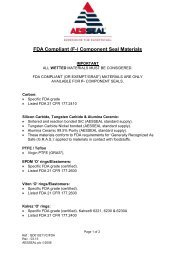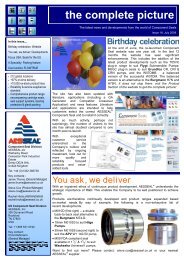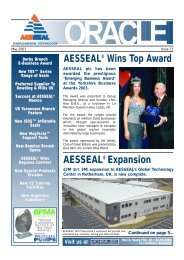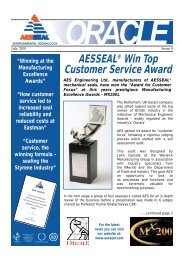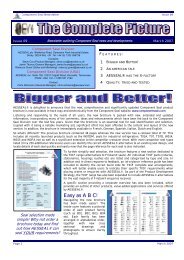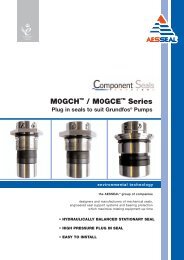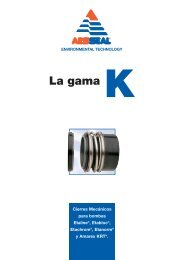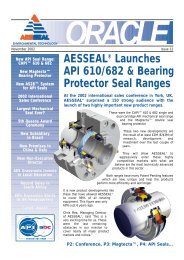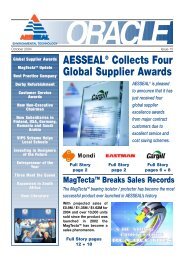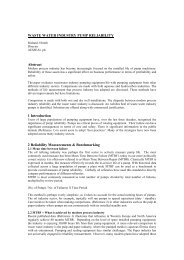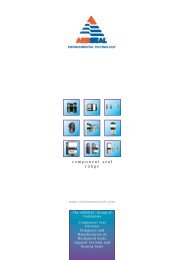ORACLE - Component Seals
ORACLE - Component Seals
ORACLE - Component Seals
Create successful ePaper yourself
Turn your PDF publications into a flip-book with our unique Google optimized e-Paper software.
Today, best practiceis that a stationaryseal design is moreappropriate with aVFD controlledpump, proving amore robust sealingsolution for highershaft speeds.The second issue concerns the ability of the seal tocirculate barrier or process fluid during shaft speedvariation. Many double mechanical seals have an integralpumping ring designed to circulate barrier fluid betweenseal faces and a seal support system. This is a closed-loopbarrier system with the barrier fluid cleansing and coolingthe seal faces, thus extending seal life. Fig. 1 shows theposition of a tapered-vane pumping ring above theoutboard rotary seal face. Some single mechanical sealsalso have pumping rings. These are typically used with API682 Plan 23 Arrangements, as shown in Fig. 3. Similarly,the purpose of a pumping ring is to circulate barrier fluidaround the closed-loop system.Speed variations will have a direct effect on the flow rateand head produced by the mechanical seal pumping ring.At low shaft speeds, resultant flow from the pumping ringmay be insufficient to overcomeresistance from inherent flowconstraints within the sealmanagement system.This could lead toincreased heatseen at the sealfaces andconsequentlyreduced seal life.The more efficient the seal pumping ring is at circulatingfluid, the greater the scope to enable effective flow with aVFD pump. Design differences lead to some pumping ringsbeing more effective than others. Some have close radialclearances between the stator and rotor which may touch,or even seize when using a VFD.Fig. 2Seal water from H.E.pumping ringHEATEXCHANGERShell CoolingWaterFig. 3Best practice as prescribed by Section 8.6.2.3 of API-6823rd Edition stipulates that radial clearances between thestator and rotor should be at least 1.5 mm (Fig. 4).By way of example, if a stainless steel rotary componentcontacted a stainless steel stationary component, ‘galling’would occur. Notwithstanding this, some doublemechanical seals are designed with radial clearancesbetween 0.25mm and 0.5mm. This is in contradiction toAPI-682 (3rd Edition), which is technically correct as shaftsare known to deflect.The tapered vane pumping ring depicted in Fig 5consistently delivered more flow and head compared withall other pumping rings when tested by AESSEAL ® . Thistapered vane pumping ring design has been featured in thedesign of over 20,000 double mechanical seals sold since2000. Importantly, but unlike some other designs, itconforms to Section 8.6.2.3 of API-682 (3rd Edition).Furthermore, it is specifically advantageous for VFDapplications, ensuring that the mechanical seal pumpingring continues to circulate fluid throughout the speedenvelope of the pump.In summary, VFDs will become increasingly popular asPlant Engineers strive to generate process improvementsand reduce energy consumption. Mechanical seals used insuch applications need to be carefully selected againstoperating conditions (considered throughout the life of thepump). Some seal designs are more capable than others ofwithstanding the associated speed envelope. Such amechanical seal should have key attributes andcapabilities. These include:i) Contact seal face technology. This is better suitedto the wide range of shaft speed applications.ii) Stationary mechanical seals which have springs inthe stator part of the seal rather than the rotating partof the seal are better suited to high shaft speedapplications. Stationary mechanical seals are oftenfound on VFD duties.iii) Mechanical seal pumping rings which comply withAPI-682 (3rd Edition) specification and deliverthe highest amount of fluid flow.Fig. 5The effect of radial clearanceClose radial clearances between counter-rotating surfacescan lead to component contact stator(gland)and ‘galling’ or bindingof the material.rotor(rotary face)Fig. 4Figure 1: A dual stationary mechanical seal - source: AESSEAL plc (Design: CAPI A1 dual).Figure 2: A conventional rotary mechanical seal.Figure 3: A single stationary plan 23 mechanical seal – source: AESSEAL plc (Design SMSS23).Figure 4: The radial clearance requirement between the mechanical seal rotor and stator, as outlined byAPI-682 Section 8.6.2.3.Figure 5. Top: view of a typical tapered vane pumping ring; Bottom: typical position of a bi-directional taperedpumping vane device within the dual seal barrier/buffer cavity of a pump (source: AESSEAL plc).www.aesseal.com15



